Gary Neal Hansen's Blog, page 28
December 20, 2018
Finding the Real Meaning of Christmas: The Apolytikion of the Forefeast of the Nativity
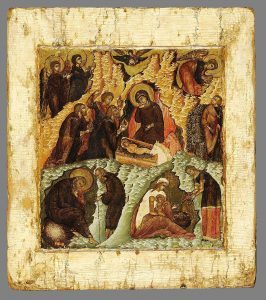
 If you are part of a Western church that tries to live into the Church year, Protestant or Catholic, you know that in Advent there is a battle afoot.
If you are part of a Western church that tries to live into the Church year, Protestant or Catholic, you know that in Advent there is a battle afoot.
Our churches tell us to focus on Advent. Advent is the ramp-up to Christmas. This season is about waiting for Christ to come — remembering Christmas is weeks or days away.
No carols, please, till the Big Day.
Our culture, on the other hand, tells us that this whole season is already Christmas. Go into a store or turn on the radio and you are barraged with Christmas carols — some are sacred music, some much more secular, but it’s all Christmas all the time.
It has been interesting to me to visit Advent services in an Orthodox church. The Orthodox are all about the Church year. They have 12 major feasts, plus seasons ramping up and cooling down for each one, plus at least one saint for every day you might show up.
But even before Advent has formally begun (in the ramp-up to the ramp-up to Christmas) they are singing hymns that declare Christ’s birth.
My first response is, of course,
They got it all wrong! They need to wait for Christmas.
Their response would surely be
We’ve always done it this way — like for over 1500 years.
Okay, maybe “different” would be a better word than “wrong.” It often is…
In any case, as in all Orthodox worship, much of the theology is carried in the hymns. There is one that I’ve heard in several services this year that carries the real meaning of Christmas.
It’s called the “Apolytikion of the Forefeast of the Nativity.”
You are probably wondering about that name.
“Nativity” is, of course, Christmas.
“Forefeast” is the ramp-up. That’s “Advent” to you and me.
“Apolytikion”? Your guess is as good as mine.
They have confusing names for all different kinds of hymns. Nobody explains. Nobody minds.
As well as having heard it multiple times on multiple occasions, the words are beautiful and fascinating. They play with Biblical images that inform the meaning of Christmas in lovely, paradoxical, meditative ways.
The REAL meaning of Christmas?
I’ll give you the full text, then I’ll share some thoughts line by line. This translation is by Fr. Seraphim Dedes from the rather remarkable “Digital Chant Stand” of the Ages Initiative.
O Bethlehem, prepare, Eden is opened unto all.
And be ready, Ephrata, for the Tree of life
has in the grotto blossomed forth from the Virgin.
Indeed her womb is shown to be spiritually
a Paradise, in which is found the God-planted Tree.
And if we eat from it we shall live,
and shall not die, as did Adam of old.
Christ is born, so that He might raise up
the formerly fallen image.
1. O Bethlehem, prepare, Eden is opened unto all.
Orthodox hymns often highlight the echoes or parallels between different scenes in the great story of salvation. “Typology” is the name for this: typically an Old Testament event or figure will be described as prefiguring or foreshadowing something in the New Testament event — especially Jesus.
In this first line of the hymn the parallel is between the Garden of Eden and Bethlehem, where Jesus was born.
The easy association is that Eden is the scene of the original creation, the place where the first human beings are portrayed in Scripture, and Jesus’ birth marks the beginning of the “new creation,” our redeemed life.
The lyric is a little more subtle than that. It points not to our first life in paradise, but rather to humanity being kicked out of the Garden. When we fell into sin, Genesis 3:23-24 tells us that God shoved us out the gate and an angel with a flaming sword guarded it against our return.
So the hymn’s first image of Christmas is this great curse is reversed. Bethlehem needs to get ready for Jesus birth, because with Jesus the gateway to paradise will be wide open to us all.
2. And be ready, Ephrata, for the Tree of life has in the grotto blossomed forth from the Virgin.
The second sentence of the hymn continues to meditate on parallels between the Garden of Eden and the birth of Jesus.
The first New Testament reference is “Ephrata” or more typically “Ephrathah,” strangely a word that doesn’t appear in the New Testament.
Matthew provides an Old Testament quotation about Jesus’ birthplace:
And you, Bethlehem, in the land of Judah,
are by no means least among the rulers of Judah;
for from you shall come a ruler
who is to shepherd my people Israel.” (Matthew 2:6 NRSV)
The thing is, Matthew misquotes the text. If you look at the original in the Prophet Micah it goes like this:
But you, O Bethlehem of Ephrathah,
who are one of the little clans of Judah,
from you shall come forth for me
one who is to rule in Israel,
whose origin is from of old,
from ancient days.” (Micah 5:2 NRSV)
So it is not quite a New Testament reference. It is the middle reference in a three-part typological structure:
Early OT story: Tree of Life back in the Garden of Eden.
Late OT messianic prophecy: Ephrata, i.e. Bethlehem.
NT fulfillment: The Virgin Mary in the Grotto.
“Grotto?” you ask.
You Western Christian, you. You probably thought Jesus was born in a barn.
The Orthodox always portray the manger in a cave — a grotto.
Aside from the question of which is more likely in terms of the agricultural architecture, the idea of a cave at Jesus’ birth makes a lovely typological echo for the tomb hewn from the rock after his death.
So yes, a grotto.
The typology in this line of the hymn, however, hinges on how we think about the One to whom Mary gave birth in that cave.
The New Testament physical personal baby was Jesus.
But the Old Testament foreshadowing is the Tree of Life from Genesis 3.
Once they ate of the tree of the knowledge of good and evil, they were no longer allowed to eat of the tree of life.
So how is it that in Bethlehem the way back to Eden will be opened to all?
Because Mary is bringing us back the Tree of Life — which is Jesus.
3. Indeed her womb is shown to be spiritually
a Paradise, in which is found the God-planted Tree.
And that leads to the third step in the typological meditation.
If Jesus is the Tree of Life (which as the source of salvation he surely is — the Way, the Truth and the Life, as he said himself) then what is the place he comes from when he is born?
The New Testament concrete reality? Mary’s womb where Jesus grew for nine months.
The Old Testament echo? Paradise itself, the place where the Tree of Life grew.
Yes, the meaning of the types has shifted, hasn’t it? In the first line Eden was our salvation, where we get to be when we receive the Tree of Life. Now in the third line Eden is Mary’s womb.
No, there is not a problem. This is not a rationalistic exercise with proof texts. This is poetry and imaginative theology.
This is worship.
This is prayer.
This is both worship and prayer when both are deeply steeped in Scripture.
4. And if we eat from it we shall live,
and shall not die, as did Adam of old.
So no, we don’t need to go to Mary’s womb.
But yes, we do need to eat of the Tree of Life. We need to come to Jesus and, as he emphasized so strongly in John 6, we need to eat his flesh and drink his blood to have life.
In practical, physical, New Testament terms we need to come to Christ in the Eucharist.
We need to receive him for our spiritual nourishment — because in typological foreshadowy terms, he is the Tree of life.
Old Testament: Adam died because he was not allowed to eat of the Tree of Life.
New Testament and our own time: We get to eat of Jesus, the Tree of Life because he sprouted from paradise, Mary’s womb.
5. Christ is born, so that He might raise up
the formerly fallen image.
Letting us eat of the Tree of Life is why Jesus was born in the first place. He reversed the curse. He brings us new and everlasting life.
And as the last line of the hymn indicates, this is something that the Orthodox treat with a very particular kind of clarity and subtlety. Christmas is, theologically speaking, a far bigger deal in Orthodox theology than in Western theology.
In the West, particularly in the Protestant world, we tend to gravitate almost always to the Cross.
You see it in Christmas ornaments in the shape of a cross — reminders at his birth that his death is what we think really counts.
You hear it in our Christmas carols and hymns —
I wonder as I wander, out under the sky,
How Jesus the Savior did come for to die…
We love Christmas, and the Holy Child whose birth we celebrate, but we have little to say about how his birth brings our salvation. At our best we point to John 1 and emphasize that he is God, the Word made flesh. But do we find real saving value in the incarnation before that Friday, thirty-some years later when he died for us?
The Orthodox point to the problem in the Garden. We turned away from God’s way and that damaged us to the core. God’s image was tainted, and our lives, every one of them, moved toward death and decay. No chance, forever after, to eat of the Tree of Life as we were intended.
Then the Orthodox point to the solution in the Grotto. God decided to be born of a woman, fully God and fully human. In the fact of his being born among us, we see our fallen nature restored, united to God’s life-giving and life-filled nature.
Jesus, the Tree of Life is born of Mary. We get to come to him by faith, to eat of him in the Eucharist, and step into the renewal of all that was broken. The door to paradise is opened to us — by the very fact of Jesus’ birth.
“And that,” as Linus said, “is what Christmas is all about, Charlie Brown.”
++++++++++++
I’d love to send you all my new articles and announcements by email. Just scroll down to the black box with the orange button and subscribe to my weekly(ish) newsletter.
The post Finding the Real Meaning of Christmas: The Apolytikion of the Forefeast of the Nativity appeared first on Gary Neal Hansen.
December 18, 2018
Monday Meditation: RCL Year C, Advent 4, Luke 1:39-55
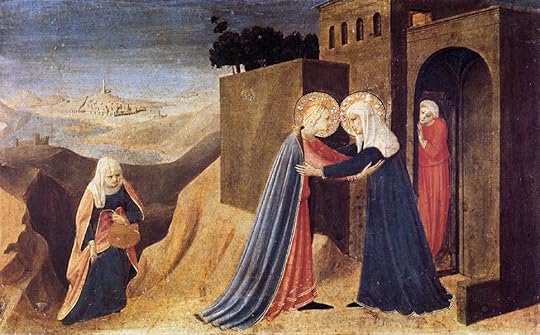 Fra Angelico, The Visitation
Fra Angelico, The VisitationOn the fourth Sunday of Advent the lectionary Gospel finally brings us to what we thought the whole of Advent should be about: the anticipation of the birth of Jesus. No more of John the Baptist and his wild preaching about turning the world upside down, leveling the mountains and filling up the valleys with the rubble.
Or maybe the distinction is not so clear.
Luke 1:39-55
Maybe this encounter between Mary, newly pregnant with Jesus, and her aged cousin Elizabeth, six months along with John, is just another testimony to the radical changes Jesus intends.
The lectionary specifies only Luke 1:39-45, which is Mary and Elizabeth’s moment of greeting. The longer section, Luke 1:46-55, is optional — but it continues the same scene, taking us through Mary’s great song of praise. I can’t leave that behind.
Four Radical Reversals
If I am lulled into sleep this Advent expecting tidings of comfort and joy, Luke 1:39-55 should effectively bring me out of it. Everything going on in this passage goes against my expectations as a Christian in 21st century North America.
1. Elizabeth’s Greeting
If I’m a typical Protestant, Elizabeth’s greeting to Mary rocks my sensibilities.
Blessed are you among women, and blessed is the fruit of your womb.” (Luke 1:42 NRSV)
It is Elizabeth’s greeting, but it comes with divine authority: not only is it in Scripture but Luke points out that she spoke because she “was filled with the Holy Spirit” (Luke 1:41 NRSV).
Why would that be shocking?
Well for one thing a lot of Protestants don’t much like to talk about Mary. We tend to think talking about Mary is a Catholic thing. And a whole lot of Protestants run away screaming from anything that is “too Catholic.”
Catholic Christians call her “the Blessed Virgin Mary,” and we don’t much like it — but here is Elizabeth, through the Spirit, calling her “blessed.”
Actually most Catholics will find this greeting extremely familiar. Along with the Angel Gabriel’s greeting to Mary from Luke 1:28 it makes up the majority of the “Hail Mary” prayer repeated in the Rosary:
Hail Mary, full of grace, the Lord is with thee. Blessed art thou amongst women, and blessed is the fruit of thy womb, Jesus.”
Many of us Protestants are very into memorizing Scripture and using Scripture in prayer. But we are so afraid of wrongly worshiping Mary that we just don’t want to memorize and pray these particular verses.
But Mary herself is about to proclaim that
from now on all generations will call me blessed,” (Luke 1:48 NRSV).
So maybe we Protestants just need to get over ourselves.
What if having a really Biblical Advent meant developing a more positive relationship with Mary — and becoming open to Christians of other traditions who love her?
2. John’s Recognition
Then for many, if not most, Protestants in North America John the Baptist’s action in this text is a shocker.
John, a six-month old fetus, is said to recognize Jesus, a newly conceived fetus, when pregnant Mary came near to pregnant Elizabeth.
We tend to think of this as a sort of whimsical poetic flourish, but what if it we took it to be true?
Some might find their views of the beginnings of human life challenged by this.
What might be the implications if a child in utero is actually sentient? Capable of recognizing someone and responding emotionally or rationally?
Others might find it challenges their views on infant baptism
The larger group of Protestants in America that this text might shock are those in the Baptist or Anabaptist traditions, and the many non-denominational evangelicals influenced by them.
Why? Because, as Martin Luther pointed out centuries ago, this passage removes one of the crucial objections people raise to infant baptism.
A couple pastors had written to Luther with their concern that baptism of infants was illegitimate. They thought personal faith was a requirement for baptism — and how could an infant have faith? Luther notes that John’s response to Jesus indicates faith — not just as an infant, but in utero.
Here’s a chunk of Luther’s reply:
Who has made you so sure that baptized children do not believe in the face of what I here prove that they can believe? … What if all children in baptism not only were able to believe but believed as well as John in his mother’s womb? We can hardly deny that the same Christ is present at baptism … who in those days came in his mother’s womb to John. …Since then he is present, speaks, and baptizes, why should not his Word and baptism call forth spirit and faith in the child as then it produced faith in John?*
A whole lot of Christian denominations don’t believe in infant baptism. When I was a seminary professor I regularly had to counsel with Presbyterians and Methodists who were up for ordination but honestly personally didn’t believe in infant baptism. What would they do?
I usually had them read Luther about John. (If you want to read it in context, here’s the book on Amazon.)
What if having a really Biblical Advent meant becoming open to infant Baptism — and to those Christians of other traditions who practice it?
3. Mary’s Self-Identification
Were I Catholic or Orthodox I might find myself a bit upended by pondering Mary’s own assertions about herself:
…my spirit rejoices in God my Savior, for he has looked with favor on the lowliness of his servant.” (Luke 1:47-48 NRSV)
This is Mary’s contribution to the biblical teaching thus far on who she was and why she was chosen. Earlier in the chapter Luke has told us that she was a virgin, that she was engaged, and, according to the Angel Gabriel, God was with her.
That’s it.
No other background is to be had in Scripture. To this, of course, and extremely significantly, we add the nature of her calling: She was appointed to be the mother of Jesus, the incarnation of God.
 Dionysius, Theotokos of Smolensk (Hodegetria)
Dionysius, Theotokos of Smolensk (Hodegetria)Therefore she is rightly called “Theotokos” or “God bearer” by the Orthodox, and “Mother of God” by the Catholics.
But these titles come to her for who she is in relation to her Son — not for what she was on her own. (Thus in icons you almost always see her with her Son, often gesturing toward him.)
As the decades and centuries rolled on, Christians told a great many stories about Mary’s life before she became the mother of Jesus. It’s a natural process. And it should also come as no surprise that many of these stories came to be treated as Mary’s actual history — no matter how fanciful.
But I think Christians do well to consider the simplicity of the biblical picture. It is not that Mary was so exceptional that God chose her to be the Theotokos. Rather she was simply a faithful person, someone who saw herself as lowly, a servant of God.
Gabriel didn’t say that Mary was with God — as if her own holiness had drawn her near.
Gabriel said that God was with her.
It was because God chose her that she became exceptional — because God placed her in the pivotal role in the history of salvation as the Mother of God incarnate.
And that does not detract the tiniest bit from her supreme place among the saints.
Surely that calling also had enormous consequences for her life going forward. I suspect any mother would tell you she found herself transformed by bearing a child. Think, then, of the transformation that comes when that intimacy of mother and child is with the Second Person of the Holy Trinity.
What if having a really Biblical Advent meant seeing that all holiness, all true transformation, is initiated not by us but by God who draws near to us in Jesus?
4. God’s Social Agenda
And then there is Mary’s amazing song: “The Magnificat” we call it, for its first word in Latin.
Mary, the lowly otherwise-unknown servant of God is chosen for a frightening and awe-inspiring role in your salvation and mine, and she sings.
But what does she sing?
She sings a song that defines what her Son actually came to do.
And for those of us in 21st-century America it is a very sobering mission indeed.
She sings as if it has already been accomplished:
The proud? Those who catch the limelight and delight in their status? Jesus has
scattered the proud in the thoughts of their hearts” (Luke 1:51 NRSV)
We all want to BE the proud, the affluent, the best — but Mary seems to say this is the way of madness. (And you can find examples to show she was right.)
The powerful? They are de-throned, no matter how insulated they are by their gates and their guards, and the systems that favor the affluent.
The lowly? The hungry? None of us wants to be standing on the street with a cardboard sign. We don’t want to be working three jobs just to feed our kids. We certainly don’t want to be waiting across a border hoping against all odds for asylum.
But Mary says the are the ones who get the blessing. Jesus lifts up the lowly (Luke 1:52). Jesus fills the hungry with what is truly good (Luke 1:53).
None of this is the American dream, right? We live in the land of hard work for upward mobility.
We’re okay with systems that help the richest get richer.
Jesus, according to Mary, is okay with sending them away empty. (Luke 1:53)
What if having a really Biblical Advent meant re-evaluating our society’s sense of what is good or great?
++++++++++++
I’d love to send you all my Monday Meditations (along with my other new articles and announcements) in my weekly(ish) email newsletter. Just scroll down to the black box with the orange button and subscribe.
This post contains affiliate links.
The post Monday Meditation: RCL Year C, Advent 4, Luke 1:39-55 appeared first on Gary Neal Hansen.
December 11, 2018
Monday Meditation: RCL Year C, Advent 3, Luke 3:7-18

 John the Baptist (Macedonia, 14th Century)
John the Baptist (Macedonia, 14th Century)On the third Sunday of Advent in Year C, the lectionary continues Luke’s telling of the story of John the Baptist’s ministry.
That’s right: a month into the period where every store and many a radio station plays nothing but Christmas carols, the Church steadfastly resists. No baby in Bethlehem just yet.
We wait, on Advent 3, for Jesus to begin his grown-up earthly ministry of teaching and healing, of dying and rising.
Last week we had Luke’s explanation of John’s ministry, in the measured poetic tones of a quotation of Isaiah. For me, and for many, the melodies of Handel’s Messiah accompanied it:
Every valley…
Every VAL-LEY…
Shall be exal…aaaaaaal….aaaaaal…aaaalted!
Last week was all calm and reflective because it wasn’t an encounter with John the Baptist.
It was commentary, explaining John the Baptist—which is far more socially acceptable.
In Sunday’s we’re going to meet John face to face. Brace yourself.
Luke 3:7-18
It helps to jump first to the end of the reading where Luke gives us a little theological framework to interpret the scene:
So, with many other exhortations, he proclaimed the good news to the people.” (Luke 3:18 NRSV)
Keep that in mind: All that comes from John’s mouth is to be understood as “good news” — or, as we like to say, “the gospel.”
It comes as a three-act drama:
Act I: The Firehose of Reproof
If John the Baptist were a movie, Luke 3:7-9 would be the “director’s cut.”
If John the Baptist were Scotch whisky, Luke 3:7-9 would be labeled “cask strength.”
Honestly, I don’t think I’ve ever heard this passage read in church in an appropriate way. We read it slowly, politely.
To get the point across, these verses need to be in a shout, a scream, a firehose-level tirade — picture your favorite heavy metal superstar, or maybe someone from the punk era, raging against society in full volume on an arena stage, light show and fireworks blazing.
That matches John the Baptist’s message:
“You brood of vipers!
Who warned you to flee from the wrath to come?
Bear fruits worthy of repentance.
Do not begin to say to yourselves, ‘We have Abraham as our ancestor’;
for I tell you, God is able from these stones to raise up children to Abraham.
Even now the axe is lying at the root of the trees;
every tree therefore that does not bear good fruit is cut down
and thrown into the fire.” (Luke 3:7-9 NRSV)
John doesn’t mince his words. He even had the stage-show costume, right? Camel’s hair, leather belt… I’m just sayin’.
So I can’t dumb him down.
When John the Baptist proclaims the “good news” it totally hurts:
he calls me insulting names
he questions the value of my heritage
he warns me that God is basically fed up with my bad behavior
So, as Larry Norman asked, what’s the “bad news”?
I don’t want to strive to have a ministry like John’s. It is too easy to play the internet prophet and cut down all the hypocritical straw-figures who hold views different from my own. Take on that role and one just becomes what one hates.
What I need to do is to receive John’s ministry. I need to listen with care and examine myself: Root out the viper within. Find the be behavior that better befits a snake in the grass than a child of Abraham. Take action before the axe hits my roots.
If John can get through to me, and get me to change my direction in time, then that really might be good news.
Act II: The Fine Points of Repentance
That’s what seems to have happened. Luke gives us three examples from which we can extrapolate. What, these three groups ask, would be an appropriate change of mind, heart, and action?
The crowds: Share your clothes with the poor. While you are at it, share your food too.
The tax collectors: Don’t gouge anybody. Be ethically upright in your work.
The soldiers: Don’t use your position to intimidate or extort. Be content instead.
All in all it is a redirection of the heart–away from self-proclaimed greatness, toward a life of God-defined goodness.
Don’t love your neighbor in some empty theoretical way. Share, be fair, and don’t abuse your power.
Love in practical ways. Start with your character and move to help real people.
Act III: The Redirection of Focus
It was easy for the crowd to think that this deeply convincing (if somewhat edgy) preacher might be their promised savior.
But the strangely quiet climax of the drama of John the Baptist is that he turns the people’s attention elsewhere.
I baptize you with water;
but one who is more powerful than I is coming;
I am not worthy to untie the thong of his sandals.
He will baptize you with the Holy Spirit and fire.” (Luke 3:16 NRSV)
You thought John and his firehose of accusation was something?
Wait,” he says, “until you meet my cousin.”
Overall, if you know the Gospels well, Jesus seems considerably more mellow than John. Okay, Jesus takes his turn at slinging insults and overturning tables. But most of his time is spent more quietly, healing, teaching, casting out demons, welcoming outcasts and foreigners.
But John knows something. He knows that his sign of baptism, turning from sin and being washed in a river, is only a beginning.
Jesus aims at deeper inner change. Just as in The Voyage of the Dawn Treader, when Aslan “de-dragoned” Eustace Scrubb, Jesus action to help us can really hurt.
It burns like a refiner’s fire. Jesus brings us step by step toward the day when the metal of our lives shines purely enough that when he looks on us he sees his own reflection.
This, by the way, is the piece of John’s ministry that I can strive for in good conscience. I want to do just as he did and draw attention away from myself so that people follow the real Messiah.
++++++++++++
I’d love to send my Monday Meditations (as well as my other articles and announcements) straight to you by email. Just scroll down to the black box with the orange button and sign up for my weekly(ish) newsletter.
The link to C.S. Lewis’ book The Voyage of the Dawn Treader is an affiliate link.
The post Monday Meditation: RCL Year C, Advent 3, Luke 3:7-18 appeared first on Gary Neal Hansen.
December 4, 2018
Monday Meditation: RCL Year C, Advent 2, Luke 3:1-6

 CC by Montana Department of Transportation-SA 3.0
CC by Montana Department of Transportation-SA 3.0Last week, as Advent began, the lectionary Gospel turned our focus from the present to the future. If we were expecting something about a baby in a manger we were disappointed. We were firmly planted in this present troubled world, looking for Christ’s coming at the end of the age.
On the Second Sunday of Advent we turn to the past — but still we are nowhere near Bethlehem.
We take just one step backward, from the present day to when Jesus was an adult and John the Baptist was preaching about major highway construction.
Luke 3:1-6
What defines Advent waiting in the second week? We wait, with John the Baptist, for Jesus to begin his public ministry.
Perhaps this is the most familiar place to be. (It seems the lectionary thinks so, since we’ll be here again next week.) By focusing on the coming of the grown-up Jesus we remember our own situation in life
We are like the crowds in the Gospels, longing for Jesus to do for us what he did for so many: teaching, healing, feeding, welcoming us in our places of deepest need.
Real Life
Luke writes the story in a way that shows he’s grounded in real life. Historians may have to wrangle a bit about his references, but he tries to be absolutely specific about when these events happened:
He names the emperor.
He names the governor.
He names three local regional rulers.
Then, for those who are tuned in to the Jewish religious context, he names the two high priests.
Message:
I am not making this up.
Luke doesn’t want you to mistake the stories of Jesus for a fairy tale.
Don’t get me wrong, there is a sense that the Gospel stories have the power of myth. By that I mean the stories speak to our deepest needs and the true nature of human experience. That’s the reason ancient myths keep getting retold.
But in the case of Jesus, as C.S. Lewis found to his delight, the myths really happened. Luke is clear: These stories took place in real life, in history, in your world and mine.
John the Baptist, John the Prophet
And what happened? The Word of God came.
Actually that’s how John’s Gospel began too — but Luke is saying something totally different.
In John the Word came in a way that had never happened before:
And the Word became flesh and lived among us…” (John 1:14 NRSV)
— Meaning Jesus.
In Luke the Word came in a way that was quite familiar to the Jewish people:
…the word of God came to John son of Zechariah in the wilderness.” (Luke 3:2 NRSV)
— Meaning John is a prophet, and God sent a message to and through him.
John is remembered by the Church as the last of the Prophets, a sort of hinge figure between the Old Testament and the New.
So at this very particular point in real human history, one last time, the Word was sent to a servant of God.
The prophets had multiple agendas.
They had things to say about how people were living right there in that time.
And they had things to say about the future hope of God’s people, especially their hope for God’s anointed one, the Messiah or Christ.
John is very much the same.
1. Our lives are a mess — that’s his message to his own “here and now.”
John was
…proclaiming a baptism of repentance for the forgiveness of sins…” (Luke 3:3)
The fact that his preaching was for the forgiveness of sins meant that people had done wrong, harmed their relationships with God and with one another — and we still do. We need to be washed clean, to heal and restore those relationships, as John showed in the washing of baptism.
The fact that he preached repentance meant people had to change — and we still do. We need to change our thinking, our understanding of ourselves, of our behavior, of our God. And that change of mind has to lead to change in our living.
2. Christ is coming — and unlike in Isaiah’s time, the Big Event was days away.
John and Jesus were relatives. They had been in their mothers’ tummies at the same time. And as Luke tells the story, John in utero had actually recognized Jesus in utero (Luke 1:41).
(Which, by the way, Martin Luther once noted as an example of faith in utero and therefore an argument for the legitimacy of infant baptism.)
So presumably John and Jesus had been in consultation. John was stepping into his public ministry of preaching and baptizing specifically to prepare for the public ministry of his cousin.
Getting a Clear View
Then Luke gives us a tidbit of John’s preaching. It sounds like a major construction project.
The hills? Mow them down.
The valleys? Fill them up — presumably with the rubble from the mountains.
The roads? Straighten out the crooked bits that used to go around the mountains or along the rivers in the valleys.
But why?
So that everyone can SEE Jesus coming.
Alluding to Isaiah 40:5, John says the leveling and filling and straightening and smoothing of things is so that
… all flesh shall see the salvation of God.” (Luke 3:6 NRSV)
The Word had become flesh back when Jesus was born. Now this Word-made-flesh was coming out into the world to teach, and heal, and feed, and welcome all. John didn’t want us to let anything block our view — nothing in our lives, and nothing in the structures of the world.
 Pulpit in San Pierre, Geneva, CC by Yann (talk)-SA 1.0
Pulpit in San Pierre, Geneva, CC by Yann (talk)-SA 1.0It reminds me of the ways 16th century Reformed Christians altered the architecture of the medieval Catholic church buildings they inherited.
In medieval Catholic worship, preaching wasn’t a big deal. It rarely even happened. The Mass focused on the Eucharist. The seating was arranged to see the altar where the priest would, at the crucial moment, hold up the consecrated elements, the Body and Blood of Christ.
For the Reformed, the main event in worship was the preaching of the Word. The Eucharist was typically celebrated only quarterly.
So for Reformed Christians to have a worship service they needed to be able to hear the preacher.
And in an age with no amplification, to hear the preacher they needed to see the preacher.
So they built these enormous pulpits and placed them prominently, arranging the seating for the best view.
The seeing and hearing of any particular sermon was a big enough thing to rework the architecture of a church. The Word was coming near and, like John and Isaiah, they really believed that all flesh should see it together.
In Advent we need to consider what in our lives needs leveling, and what needs filling, and what needs straightening. We need to be able to see him coming.
++++++++++++
Know someone who has to preach their first sermon? Have them check out my new mini-course up there in the top menu (or through this link). I’ll help them get from here to Sunday in five manageable steps.
The post Monday Meditation: RCL Year C, Advent 2, Luke 3:1-6 appeared first on Gary Neal Hansen.
November 27, 2018
Monday Meditation: RCL Year C, Advent 1, Luke 21:25-36
 Sunday the new year officially begins for the Western Church — it is the first Sunday of Advent. Everything starts with four weeks of waiting for the coming of Christ.
Sunday the new year officially begins for the Western Church — it is the first Sunday of Advent. Everything starts with four weeks of waiting for the coming of Christ.
Year C
And with that a new cycle of the Lectionary begins: we now are in “Year C” in which the Gospel readings will mostly come from Luke.
You might be expecting that with Advent and Luke we would jump to the great stories of Gabriel, of Zechariah and Elizabeth, of Mary and Joseph and the birth of Jesus. Chapters 1 and 2 of Luke have Advent written all over them. (And if you want to spend your Advent diving deep into those texts, see the info about my online class at the bottom of this page.)
But that is not how the readings for Advent are put together.
Luke 21:25-36
On Advent 1 we look to the coming of Jesus, not as a baby in Bethlehem, but at the end of the age. The text (Luke 21:25-36) is actually part of the same Holy Week speech we heard a couple weeks ago from Mark.
As I said then, these texts about the end of the age, whether in the Gospels, the Epistles, or the Prophets, always push at least a portion of the Christian reading public to piece them all together and make a calculation about whether we have days, years, or centuries to wait.
Let’s not. There is more important stuff to attend to here.
First, there are a couple brief but interesting theological issues.
1. The claim of Messiahship
Just in passing, by quoting Daniel, Jesus connects his predictions to the Old Testament apocalyptic tradition.
Then they will see ‘the Son of Man coming in a cloud’ with power and great glory.” (Luke 21:27 NRSV)
Compare Daniel:
I saw in the night visions, and, behold, one like the Son of man came with the clouds of heaven,…” (Daniel 7:13 KJV)
It seems like a claim about himself, of his own messiahship and apocalyptic role, at least in the context of his statements earlier in the chapter.
2. The question of timing
Jesus doesn’t come to the aid of those who want to predict his return in our time, however. In the simplest reading of the text, he seems to say that his predictions are about the very near future of the Apostles:
Truly I tell you, this generation will not pass away until all things have taken place.” (Luke 21:32 NRSV)
So… by that statement he’s not talking about now, nineteen centuries and change since the death of the Apostles.
He’s really emphatic about the reliability of the claim:
Heaven and earth will pass away, but my words will not pass away.” (Luke 21:33 NRSV)
Hmm… It’s almost as if he suspected people in centuries to come might make the mistake of thinking it was about their own future.
Beyond those little notes, though, I think it is wise to look to see what Jesus actually asks of us in this passage.
3. The call to confidence and joy
Christians often let these passages fuel the fires of anxiety.
We use them to scare nonbelievers into conversion.
And we get kind of freaked out ourselves, especially if we aren’t quite sure which side of the old “sheep vs goats” thing we’ll find ourselves on at the final judgment.
But that really doesn’t seem to be Jesus’ intention.
In this passage Jesus acknowledges that people are going to get scared when the “signs” come.
People will faint from fear and foreboding of what is coming upon the world, …” (Luke 21:26 NRSV)
And who doesn’t get frightened by wars, and earthquakes, and famines, distress among nations, tsunamis? Disasters, whether natural or of human origin, are terrifying.
But Jesus tells us that, at least to the degree that these things are tied to the timeline of his return, we should take hope.
Now when these things begin to take place, stand up and raise your heads, because your redemption is drawing near.” (Luke 21:28 NRSV)
Don’t think of these things as signs of judgment. Remember instead that the One who is coming loves you and will make all things well.
When is the end? Who knows, really. Paul didn’t claim to know. He just said it was sooner now than when we first came to faith (Romans 13:11).
Like every 24 ours it gets one day closer.
4. The call to watch
So what do we do in the meanwhile? We are called to keep watch.
Be on guard…” (Luke 21:34 NRSV)
Be alert at all times…” (Luke 21:36 NRSV)
I think that it is pretty easy to get this very slightly wrong and be back in the “let’s predict of the end times” club.
Does keeping watch mean focusing our attention on which signs and symbols relate to which events in the newspaper? I don’t think so.
The question we should ask is “HOW should we keep watch?”
The first part of the call is to maintain good spiritual and mental health. Really. Check it out:
Be on guard so that your hearts are not weighed down with dissipation and drunkenness and the worries of this life,…” (Luke 21:34 NRSV)
Dissipation?
“Dissipation”? To be quite honest, I haven’t heard many Christians say they were working hard to get past their dissipation. But maybe it’s worth a thought.
Dissipation means squandering our resources — our good stuff goes to nothing, like when smoke spreads out and disappears.
We spend too much and our finances are dissipated.
We put our attention into social media and our time is dissipated.
There are countless ways a person can pour out what is good and valuable in life and see it just spread out and be gone.
A good spiritual practice might be in order to bring some focus. (Like maybe an Advent course on classic lectio divina? Read on, my friend, read on.)
Drunkenness?
“Drunkenness” is pretty obvious. But then there are a bunch of other things besides alcohol that can be addictions and consuming passions.
Drugs, gambling, eating, spending, video games, sex…
Our addictions lead our lives out of control and bit by bit erode our relationships, our vocations, our well-being.
Maybe a good 12-Step program is the thing to pursue.
The worries of this life?
“The worries of this life?” Well that’s a kicker. Who doesn’t have worries? Relationships, jobs, homes — we worry if we don’t have them, then we worry when we get them.
Something is needed in our spiritual life to nurture the deep-down trust in God called faith.
Personally I think we need to go to Scripture, and as the old collect in the Book of Common Prayer puts it, “read, mark, learn, and inwardly digest” it.
We need to really chew on the stories that teach us God’s goodness, faithfulness, and providence.
We need to soak ourselves in the passages that proclaim God’s promise to us in Christ.
We need to pursue the daily, tiny, faith-sized steps of trust in God’s goodness and God’s promises.
That’s the antidote to the worries of this life.
All of those steps toward spiritual health? They define keeping watch this Advent. And they lead to having the strength to stand firm before Christ, no matter the situation. And that’s the second part of the call in our passage. (Luke 21:36)
++++++++++++
My Advent course on the ancient spiritual discipline of lectio divina (or “divine reading”) is open for registration! This Advent can be a time of real renewal
approaching Scripture in a way that is prayerful
practicing prayer in a way steeped in Scripture
There is even an option to use the materials as an adult education class for your church.
Click here for full information
The post Monday Meditation: RCL Year C, Advent 1, Luke 21:25-36 appeared first on Gary Neal Hansen.
November 19, 2018
Monday Meditation: RCL Year B, Christ the King, John 18:33-37
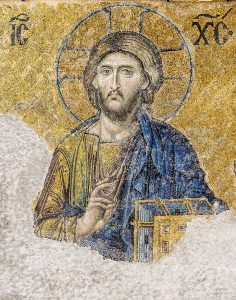
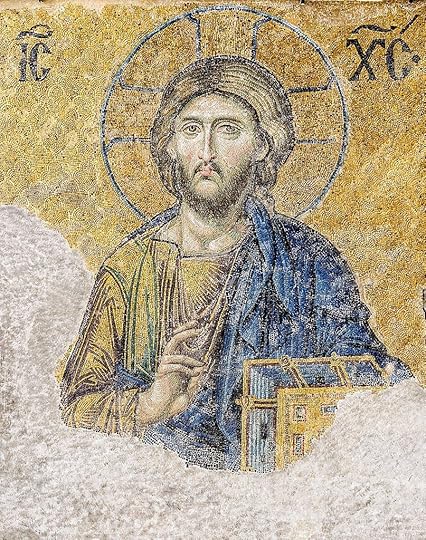 Christ Pantocrator, Hagia Sophia
Christ Pantocrator, Hagia SophiaThis Sunday is the celebration of “Christ the King,” the last Sunday in the Western Church year.
Christ the King
Mainline Protestantism seem to take this celebration in stride, as if it were as ancient and venerable a part of the calendar as Easter, or Lent, or even Christmas. The youngest of those key celebrations go back a millennium and a half. The oldest go back to the very beginning.
Christ the King? Not quite a century.
The Roman Catholics instituted Christ the King in 1925.
But then they created the three year lectionary after Vatican 2 in the 1960s.
It seems that when the Protestants adapted and adopted the Catholic lectionary (completing the process with the RCL in 1994) Christ the King came along for the ride.
Personally, I like it.
We live in a world where all matters of religious and spiritual conviction have been reduced to a sort of marketplace. We pick and choose, using our individual discernment and taste to take what we like, or want, or need, and leave the rest behind.
And in our well-intentioned efforts to love our neighbors who hold different convictions, we soften any, or at least many, claims of particularity for our faith.
So on Christ the King Sunday we should remember that the risen Christ said, when he gave his followers their Great Commission,
All authority in heaven and on earth has been given to me.” (Matthew 28:18, NRSV)
That’s the authority of Christ, the King. His cross and resurrection had wrested that authority from the opposing team who, when Christ was tempted in the desert, showed him all the kingdoms of the earth and proclaimed blithely,
All these I will give you, if you will fall down and worship me.” (Matthew 4:8-9)
The story of the Good News of Jesus is that the world was under Satan’s reign, but it is no longer.
Christ reigns as the Ruler of All, the “Pantokrator,” which is the name of the icon inside the dome of many an Orthodox church.
He looks down on us, his followers, who presumably are under his more particular reign, despite our behavior to the contrary.
Some versions of the icon have him looking rather grumpily at his subjects. But in the better renditions, like the great mosaic in the ancient church of Hagia Sophia in Constantinople/Istanbul, his expression is more inscrutable:
He is the serene and majestic ruler, powerful with the right to judge, but gracious and in rich in mercy. His look reminds me of C.S. Lewis’ Aslan in The Lion, The Witch, and the Wardrobe:
He’s wild you know. Not like a tame lion.
Anyway, onward to the text:
John 18:33-37
In the lectionary’s Year B, Christ the King has us in John 18:33-37. It is Holy Week. Jesus has been arrested. He stands before Pilate who peppers him with questions.
Are you the King of the Jews?” (John 18:33 NRSV)
I am not a Jew, am I?” (John 18:35 NRSV)
What have you done?” (John 18:35 NRSV)
So you are a king?” (John 18:37 NRSV)
And finally, when Jesus says that what he really does is testify to the truth, one line after our reading ends Pilate asks him,
What is truth?” (John 18:38 NRSV)
What Is Truth?
Maybe it is good that the RCL left off verse 38, at least this year. I might spend my meditation time, and you might end up preaching, about “alternative facts,” and the assertion that “truth isn’t truth” and the constant accusations that well researched and fully documented investigative journalism is “fake news.”
But let’s not go there. It isn’t part of the reading.
Let’s instead focus on two aspects of Jesus’ answers to Pilate’s anxious stammering barrage of questions.
1. A Kingdom Not of this World
In the preliminaries, Pilate asked Jesus if he were king of the Jews. Jesus replied by strongly implying that Pilate was a tool of other people, without a thought of his own to his name (vs. 33-34).
(Pilate pretty well proves Jesus’ assessment when he releases Barabbas because the crowd demands it, and crucifies Jesus despite believing him innocent. But that’s after this passage.)
But when Pilate presses the question, asking just what Jesus did to get arrested, Jesus responds.
Of course Jesus responds in a very Jesus-like way. Instead of directly addressing Pilate’s questions, he brings up a seemingly unrelated point:
My kingdom is not from this world.” (John 18:36)
He doesn’t say he is a king. And he doesn’t say he’s done anything. But he does say he has a kingdom…
Christians have tried to make it seem as if Christ’s kingdom is actually here on earth.
That includes medieval Catholic claims of papal power over heads of state, and his direct rule of territories.
That includes Orthodox so intertwining of the Church with the state that when states make troubling decisions the Church appears to endorse them.
That includes Protestant claims that America is in some sense a Christian state, and that this should somehow limit the rights of those committed to other religions.
And ever since 19th century and the rise of classical liberalism, Christians have from time to time viewed their mission as bringing God’s kingdom on earth — even transmogrifying this into the views of 20th century evangelicalism.
But in the Bible Jesus doesn’t try to lay claim to an earthly kingdom, either when offered one by Satan or when pressed toward it by zealots among his followers.
Jesus told the earthly authority that his kingdom was absolutely not of this world. And for his followers, the point is that their primary allegiance, their citizenship beyond any earthly country, is in that unearthly kingdom.
2. Kingdom? Maybe There’s a Better Word
Jesus’ last speech in our text attempts to answer Pilate’s question about whether Jesus is, in fact, a king. He gives a fascinating answer — pure and distilled Gospel of John. Take a look:
You say that I am a king. For this I was born, and for this I came into the world, to testify to the truth. Everyone who belongs to the truth listens to my voice.” (John 18:37 NRSV)
What is this “not of this world” Kingdom? Well it isn’t about a political allegiance. The language of kingdoms and citizenship is only an approximation, the best attempt that human language can make to capture it.
But what is it?
Ultimately it is commitment to truth.
Q: Are you a king, Jesus?
A: I came to testify to the truth.
That’s his definition of the Kingdom. At least one of his definitions. He has a whole bunch of parables that also try to define it.
We Christians sometimes get kind of goofy about our commitment to the truth.
We proclaim that the Bible is God’s Word, and we treat it as a list of clear and definable propositions about all the things that we need to know. Then we end up proclaiming things adamantly as absolute truth while many people who actually study those things — like scientists, and historians, and archaeologists — come to very different conclusions.
Jesus wants us to be deeply committed to the Truth.
We can start with the simple and straightforward sense of accepting evidence. Like, rather than fooling ourselves based on ideological propaganda.
And in a rather different way, Jesus, also in John, says that he personally is the Truth.
Truth is a person, not a proposition.
Truth is a person, not a political party.
Truth is a person, not an ideology.
If you know him, seek to know him better, and to follow him wherever he leads.
And if you really belong to the truth, you’ll recognize his voice calling.
++++++++++++
My Advent course on the ancient spiritual discipline of lectio divina (or “divine reading”) is open for registration! This Advent can be a time of real renewal
approaching Scripture in a way that is prayerful
practicing prayer in a way steeped in Scripture
There is even an option to use the materials as an adult education class for your church.
Click here for full information
(The link to the book The Lion, the Witch, and the Wardrobe is an affiliate link.)
The post Monday Meditation: RCL Year B, Christ the King, John 18:33-37 appeared first on Gary Neal Hansen.
November 15, 2018
Letters to a Young Pastor: Dealing with Grief

 Old Man Grieving — Van Gogh
Old Man Grieving — Van GoghDear ______:
I am so very sorry to hear that your mother has died.
I once heard a very wise friend say “The world changes when a parent dies,” and surely it is true. Of course they are the direct source of our own lives, but that’s a bit theoretical. We get to know our own existence in the company of our parents. From our earliest moments their presence defines the world.
And then they are gone.
Dealing with Grief
There are no words that would lessen the loss, so I won’t try. I’ll be holding you before God in prayer, and were we in the same city I’d try to spend time keeping you company.
I wouldn’t offer any advice at all except that you asked me for some.
Here you go: Learn from the long-established practices of the Jewish community.
Our own Christian practices are so widely varied that one can say little about them. And so often they are simply improvised, drawing on little or no wisdom from larger community.
I’m not an expert on Jewish practice but I’ve learned of two things they do in a time of grief that are extremely helpful.
1. Sitting Shiva
For seven days, starting after the burial of a loved one, relatives give grief their full attention. Traditionally they stay home and others visit, so they can talk about their loss and their memories.
Think of it as a full week to honor the memory of the one who has died, and to make room for the intense feelings that loss brings. Being together provides support and encouragement.
Life will resume its normal routines after those seven days. Grief isn’t over by any means, but tending to it as fully as possible for a week may brace you for what lies ahead.
As Christians we are at a disadvantage here. Our communities don’t have this as an established practice. Sometimes we stay apart instead, not knowing what to say to someone who is grieving. We may drop by with a meal but we don’t stick around.
But you can still learn from the wisdom of Jewish practice. Take the week off. Tend to your soul. Be with friends who know you are grieving. Don’t give in to the world’s demands that make you think you must stay at work or whatever else cries out for attention.
2. Saying Kaddish
When my father died, days turned to weeks, and weeks to months, and still the low cloud of grief was there. Often enough, and at the oddest moments, low clouds turned to storms and feelings became overwhelming.
Then I remembered a novel by one of my favorite writers, Chaim Potok’s Davita’s Harp. In the book a young secular Jewish girl must deal with the death of her father. She finds her way into the praying community at a synagoge and she learns an ancient Aramaic prayer called the “Mourner’s Kaddish.”
The Kaddish is prayed after the death of a family member in the three services of Jewish daily prayer. For a parent one prays it for 11 months.
I found myself longing for something like that, something I could do daily to help me in my grief, long after the people around me were thinking about it and saying comforting things.
The thing is, though, it isn’t prayed alone. There are required responses from the congregation. For a Jew that means at least ten people.
I figured as a non-Jew my quorum would have to be my wife. So for 11 months, three times a day, I said Kaddish. If I was at work or traveling we would do it over the phone.
And it helped enormously.
Text of the Mourner’s Kaddish
Here’s the text in English (I can’t remember which website I got it from):
Exalted and hallowed be His great Name.
Congregation responds: “Amen.”
Throughout the world
which He has created
according to His Will.
May He establish His kingship,
bring forth His redemption
and hasten the coming of His Moshiach.
Congregation responds: “Amen.”
In your lifetime
and in your days
and in the lifetime of the entire House of Israel,
speedily and soon,
and say, Amen.
Cong: “Amen. May His great Name be blessed forever and to all eternity, blessed.”
May His great Name be blessed forever and to all eternity.
Blessed and praised,
glorified, exalted and extolled,
honored, adored and lauded
be the Name of the Holy One, blessed be He.
Congregation responds: “Amen.”
Beyond all the blessings, hymns, praises and consolations that are uttered in the world;
and say, Amen.
Congregation responds: “Amen.”
May there be abundant peace from heaven,
and a good life for us and for all Israel;
and say, Amen.
Congregation responds: “Amen.”
He Who makes peace in His heavens,
may He make peace for us and for all Israel; and say, Amen.
Congregation responds: “Amen.”
Remembering God’s Goodness in the Midst of Sorrow
You will notice that there is no mention of grief here, or of the person who has died. It is a reminder of the glory and the goodness and the promise of God. For me, remembering those things in this ancient prayer was eleven months well spent.
Saying Kaddish was the single most helpful thing I did to heal when my father died.
I commend the practice to you, my friend. May God be with you as you grieve this deep loss.
Blessings,
Gary
++++++++++++
The link above to Chaim Potok’s novel is an affiliate link.
The post Letters to a Young Pastor: Dealing with Grief appeared first on Gary Neal Hansen.
November 12, 2018
Monday Meditation: RCL Year B, 33rd Sunday in Ordinary Time, Mark 13:1-8

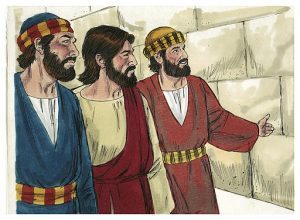 CC Distant Shores Media/Sweet Publishing 3.0
CC Distant Shores Media/Sweet Publishing 3.0And so, on the 33rd Sunday of Ordinary Time, the Revised Common Lectionary bids goodbye to its year with the Gospel of Mark. (There is one more Sunday in the year, but the Gospel for “Christ the King” Sunday will be John.)
The text is Mark 13:1-8 — which is just the beginning of Jesus’ discussion of things apocalyptic.
Maybe it’s a mainline sort of choice, reflecting the traditional Protestants and Catholics who tend to use the RCL. (Let’s have as little as possible about the signs of the end of the age, thank you very much.)
But you could also say that this week brings the story full circle. On Advent 1 the year began with another chunk of the same chapter’s predictions of Christ’s second coming (Mark 12:24-37).
The year of Mark begins and ends with its eye on the end of the age.
Mark 13:1-8
This week’s reading is a tidy little segment of the much larger passage.
1. Jesus and some disciple talk about the big buildings around the Temple.
2. The two pairs of brothers among the Apostles ask for a private consult on the signs of the end.
The Big Buildings
Earlier Jesus and the gang had their discussions with (and about) the scribes, and then they chatted about the people giving donations in the Temple. Now they are going on their way.
One disciple, maybe someone who didn’t make it to the big city very often, is impressed by the buildings.
Look, Teacher, what large stones and what large buildings!” (Mark 13:1 NRSV)
Though it dates me, I can’t help but hear Gomer Pyle USMC here with his long drawn-out
Golly!
Jesus’ response to the country bumpkin’s wide-eyed wonder?
Do you see these great buildings? Not one stone will be left here upon another; all will be thrown down.” (Mark 13:2 NRSV)
I’m not sure Jesus was intending to open up a can of apocalyptic worms here. It seems to me like a simple splash of cold water to refocus the disciple on what really matters.
The rest of the conversation went something like this:
Hey, are you impressed by human creations? Think long term: the biggest and best things we make will eventually crumble. Focus on the eternal. Let me tell you a story about the Kingdom of Heaven…
Mark left that part out. Okay, it actually came straight from my imagination. But it might have been like that.
The Signs of the End
It was Peter, Andrew, John, and James who heard a bit of the conversation and figured Jesus was talking end times. They wanted to know more.
If the buildings are going to fall, we want to know when. Will there be signs? Is this gonna be some of that crazy stuff we read about in the prophet Daniel?
Again, Mark left out this fuller version of the conversation. It’s really my paraphrase of what they did ask in private:
Tell us, when will this be, and what will be the sign that all these things are about to be accomplished?” (Mark 13:4 NRSV)
And honestly, ever since, when Christian conversation turns to the End Times, someone in the room has tried to make some calculations. We sift the clues. We plot out the symbols. We line it up on a time line. And we decide that Jesus is coming again sometime in our own lifetime.
Sometimes, whether in the middle ages or in every recent century, groups gather around leaders and prepare for the end.
Sometimes they sponsor conferences and create handy charts, or publish detailed books on the prophesies to make it all seem convincing.
Sometimes they start whole new religious sects.
Sometimes they just write best selling novels about it.
They foster a lot of fear, and live in a lot of anxiety about it.
Anyway, Christians are able to get their knickers in a knot with the feeling that Jesus is coming day after tomorrow.
Jesus himself is actually kind of low key about it.
He has three words of wisdom on the topic.
1. Don’t be led astray by people claiming to know too much.
First word: Watch out for those who claim to know too much about the end times.
Specifically, watch out for those who make claims about being Jesus.
Many will come in my name and say, ‘I am he!’ and they will lead many astray. ” (Mark 13:6 NRSV)
He repeats the instruction later, expanding it to those who say not “I am he!” but “There he is!”
And if anyone says to you at that time, “Look! Here is the Messiah!” or “Look! There he is!”—do not believe it. False messiahs and false prophets will appear and produce signs and omens, to lead astray, if possible, the elect.” (Mark 13:21-22 NRSV)
 Photo on Twitter: Diana Buttler Bass
Photo on Twitter: Diana Buttler BassYou’d think someone who claims to be Jesus in the flesh would land in the psych ward.
But people are so vulnerable. The anxious and the ill-informed, the lonely and the broken, can be preyed upon by those claiming to be the savior.
You find it in the news. Too many people get swept into dodgy dangerous groups following the bold claims of leaders. Within my lifetime members of such groups have been led to mass suicide, to murder, to sexual abuse, and other evils.
Jesus is clear: anybody claiming to be him isn’t.
Real leaders have more of the attitude of John the Baptist:
He must increase, but I must decrease.” (John 3:30 NRSV)
2. Don’t be led astray by what you see on the news.
Second word: Don’t waste your time pegging the events of the day to the apocalyptic time line.
People looking for signs of the end in human conflict, the rise of evil leaders, or natural disasters always have a ready-made hobby.
There are always wars, and rumors of wars, says Jesus.
…this must take place, but the end is still to come.” (Mark 13:7 NRSV)
Then, comes the repetition, as if it were the second half of a parallelism in a piece of Hebrew poetry. As well as strife between nations, says Jesus, there are always famines and earthquakes.
This is but the beginning of the birthpangs.” (Mark 13:8 NRSV.)
That is, signs or no signs, there is still a lot to happen before the end — and a lot of work to be done. After all,
… the good news must first be proclaimed to all nations.” (Mark 13:10 NRSV)
3. Don’t Panic
Jesus’ third word of wisdom is familiar to every reader of The Hitchhiker’s Guide to the Galaxy:
Don’t Panic.
If the lectionary had given us the full chapter of apocalyptic prediction, the chorus we would have heard should lead us to calm down.:
…do not be alarmed…” (Mark 13:7 NRSV)
As for yourselves, beware…” (Mark 13:9 NRSV)
…do not worry…” (Mark 13:11 NRSV)
But be alert; I have already told you everything.” (Mark 13:23 NRSV)
Beware, keep alert; for you do not know when the time will come.” (Mark 13:33 NRSV)
Therefore, keep awake—for you do not know when the master of the house will come…” (Mark 13:35 NRSV)
And what I say to you I say to all: Keep awake.” (Mark 13:37 NRSV)
Pay attention, yes, but don’t freak out.
There’s going to be bad stuff in the world. But the one who is coming is good. He loves you.
And remember: The only Jesus is Jesus, the Word made flesh, who came to dwell among us and will come again. When he wants to.
++++++++++++
If you want Advent to be a real time of renewal, think about joining my upcoming class on the classic Christian spiritual discipline called lectio divina. It is a prayerful way to dive deeper into Scripture, and a scriptural way to dive deeper into prayer. You can get on the waiting list to be sure you get a notice when it launches in a week or so.
(By the way, the link to The Hitchhiker’s Guide to the Galaxy up there is an affiliate link.)
The post Monday Meditation: RCL Year B, 33rd Sunday in Ordinary Time, Mark 13:1-8 appeared first on Gary Neal Hansen.
November 7, 2018
Monday Meditation: RCL Year B, 32nd Sunday in Ordinary Time, Mark 12:38-44
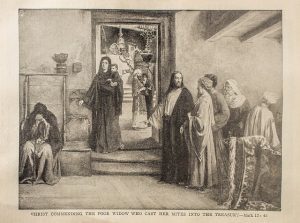
 CC by melodi2 2.0
CC by melodi2 2.0The Gospel for the 32nd Sunday in Ordinary Time (Mark 12:38-44) gives us two distinct stories. They are, in my opinion, linked primarily by the fact that Mark told them back to back.
There is one small point of contact shared between them, and depending on how you think about that point you could argue a larger subtle connection.
Mark 12:38-44
Story 1: Jesus rants a bit about the scribes for doing stuff to get the praise of others.
Story 2: Jesus praises a widow for an objectively small but personally sacrificial offering.
Point of contact: Widows.
Story 1
In the first story, seemingly out of context, Jesus complains about the attitude of the scribes. But it isn’t really so random. It is the end of a conversation with the scribes.
In last week’s text (Mark 12:28-34) it was a scribe who came up to Jesus to test him, asking about the greatest commandment.
Then the lectionary skips a short passage (Mark 12:35-37). Jesus turns the conversation around and tests the scribes. He asks why the scribes say the Messiah is David’s son, when David himself calls the Messiah his “Lord.”
This was both a stumper and a crowd pleaser. Perhaps we should imagine the scribes slinking away with heads hung low.
So Jesus sees the retreating backs of his debate opponents, and says that they exemplify something he really doesn’t like. As he said in other words in other contexts, seeking to make yourself look good at all costs is a pretty rotten approach to life.
So, in a time when it is more common and much easier to turn the gaze outward and accuse others of being self-absorbed monomaniacal narcissists, I think the passage is calling me to self-examination.
Time to root out my own tendency to Dress for Success, because
Beware of the scribes, who like
to walk around in long robes,..” (Mark 12:38 NRSV)
and my tendency to be glad in successful networking with the Right People, because
Beware of the scribes, who like …
to be greeted with respect in the market-places” (Mark 12:38 NRSV)
and my tendency to do a big fist pump and shout “YES!” when I get to be seen at the Right Place at the Right time, because
Beware of the scribes, who like …
to have the best seats in the synagogues and places of honor at banquets!” (Mark 12:38-39 NRSV)
Time to lay aside my pleasure in such things. At least it’s time to give up my active efforts to seek them, to measure my worth in their terms.
Better to seek to do the good thing, and to seek to do what I do well — without regard to lusting after praise. Jesus has a low view of my desire to live on the praises of others.
Story 2
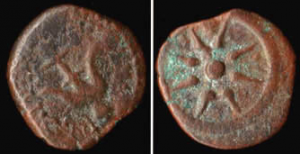 Widow’s Mite
Widow’s MiteThe second story, since it lands mid-November, makes me ask how much effort the lectionary committee was making make sure preachers had a text for their stewardship campaigns.
Jesus sees all kinds of people making big donations to the temple fund…
Except then, when nobody else is looking, this little old lady steps up.
She’s a widow. That pretty well defines her poverty back in those days. She has a tiny bit of money to spend on anything — just a quarter or a dollar bill maybe.
You may have had those seasons when all you could put in the plate was a buck. You wondered if the ushers were looking in there and thinking
Cheapskate.
Not Jesus. He sees this woman, knows her situation, knows her heart, and he values it all proportionally.
In God’s math, who is giving more?
The former CEO who bundles up the profits on the sale of their stock options to create a charitable foundation and goes back to the big house for dinner?
Or the single mom working two jobs to make ends meet but who still brings a couple cans of chili for the food bank basket in the back of the church?
You figured it out.
Don’t get me wrong: I think Jesus is still really happy when the rich give heaps and bushels of money to the church or the poor or a non-profit.
It’s just that Jesus values changed hearts more than anything — and you really see the change when someone gives when it is hard. That’s what you see when someone who is struggling still gives.
We all need the changed heart, and we all need to give, and there is an endless supply of needs we can give to.
Point of Contact
The point of contact between the two stories is widows.
In complaining about the scribes, Jesus says, in passing,
They devour widows’ houses…” (Mark 12:40 NRSV)
And then the second story, of course, he praises the widow who gave so generously.
The idea that the Scribes devour widows’ houses is kind of weird, actually. He doesn’t give us any clues as to the mechanism.
Maybe they devour widows houses by focusing so hard on what others think of them, their standing, status, and reputation, that they just don’t look at the poor. Neglect has unintended consequences.
Perhaps it’s a stretch, but is there some kind of tie between those unintended consequences and the generous widow hidden in Jesus’ statement elsewhere about giving to those in need?
When you give alms…” (Matthew 6:3)
It isn’t “if” you give alms. And giving alms isn’t something as distant as paying taxes to create a social safety net, happy as I am that we do that. Almsgiving is personal. Old fashioned, but personal.
If we attend only to ourselves, we won’t be caring for others directly or indirectly — and in the end, the poor, the widows of the text, will have their houses devoured.
Having your home devoured is not a bad way to describe the process of becoming homeless. Repossession and eviction are a very big reality for the poor.
Is there a bigger connection? Maybe so. Maybe it is the big contrast between the Scribes who aggrandize themselves and the widow who acts so humbly, and serves others through humble giving.
Someone will surely have an opinion. I hope you’ll share yours in the comments!
++++++++++++
Hoping for a way to make time in Scripture more a prayerful encounter with God? Get on the waiting list for my Advent course on the classic spiritual practice of lectio divina.
The post Monday Meditation: RCL Year B, 32nd Sunday in Ordinary Time, Mark 12:38-44 appeared first on Gary Neal Hansen.
November 1, 2018
Monday Meditation: RCL Year B, 31st Sunday in Ordinary Time, Mark 12:28-34

 Ten Commandments 1768 (public domain)
Ten Commandments 1768 (public domain)This week I am amazed to have reached Thursday night without posting for you my “Monday Meditation.”
Well, I’ve never had a week quite like this. Saturday morning, at a synagogue maybe a mile from my home in Pittsburgh’s Squirrel Hill neighborhood, a man armed with an assault rifle and several handguns came in and murdered eleven worshippers, shouting anti-Semitic statements.
He too was shot. He had his wounds treated by Jewish physicians at a local hospital, apparently continuing with his insults all the while.
I’m not getting a ton of work done. Walking down the street I’m prone to bursting into tears.
I have no idea whether the murderer professed my faith or not but, God knows, countless anti-Semitic murders and other atrocities have been done ostensibly in the name of Jesus.
That’s totally wrong.
I tell you that murder, and the hatred that drives it, is wrong on the basis of this Sunday’s lectionary Gospel.
Mark 12:28-34
The story of Mark 12:28-34, with variations, is found also in Matthew and Luke.
Someone comes to Jesus.
That someone asks what command is greatest or first, or how to inherit eternal life.
Jesus states, or agrees, that the answer is found in the Jewish scriptures:
Hear, O Israel: The Lord is our God, the Lord alone. You shall love the Lord your God with all your heart, and with all your soul, and with all your might.” (Deuteronomy 6:5-6)
Then Jesus agrees, or states unasked, that a second command is ranked right up there with the first. Again the answer is from the Jewish scriptures:
… you shall love your neighbor as yourself: I am the Lord.” (Leviticus 9:18 NRSV)
There is a lot to say about these texts.
The Command to Love God
I could say quite a lot about how the command to love God encompasses the whole of a person in a growing relationship, not just an ideology or set of objective “truths.”
The Command to Love Neighbor
I could say quite a lot about how the command to love neighbor is almost always misquoted — we say “love your neighbor as you love yourself” but that is not the text of Leviticus or the Gospels.
We are to expand our sense of who our “self” is and enfold the neighbor: Love someone outside your body as part of your own self.
Augustine of Hippo
But instead I’ll tell you where my meditations were on Monday and have remained all week: St. Augustine of Hippo.
If you don’t know Augustine, it’s time to broaden your horizons. This 5th century African bishop was the single most influential thinker and writer in the history of Western Christianity.
And Augustine made a very big deal about those two commandments. That’s reasonable, right? I mean Jesus said they are the most important, following them is the path to eternal life, on them hang all the law and the prophets.
For Augustine these two commands are more than legal precepts by which to mold our behavior and by which we will be judged. They are descriptive of the nature of the life God created for us.
That is, live was intended to be lived oriented fully toward the love of God, and within that love of God to the love of neighbor. That’s the way of life that leads to true blessedness, real happiness, because it is in tune with our nature and the nature of the world.
Anything else is out of balance, and at best we limp along like a bike with broken spokes or a car with a flat tire. It leads to destruction. And that doesn’t have to be punishment. It’s just that life crashes and burns if it isn’t true to its creator’s intent.
The “Rule of Love” in Biblical Interpretation
But here’s what I want to share with you about Augustine and these two great commandments: For the great bishop and theologian, these commands provide a principle of biblical interpretation.
And biblical interpretation should be at the forefront of our minds, since in Matthew Jesus says
On these two commandments hang all the law and the prophets.” (Matthew 22:40)
So for Augustine these commands function the way a ruler does for someone trying to draw a straight line. Here’s how he put it:
Whoever, then, thinks that he understands the Holy Scriptures, or any part of them, but puts such an interpretation upon them as does not tend to build up this twofold love of God and our neighbour, does not yet understand them as he ought. If, on the other hand, a man draws a meaning from them that may be used for the building up of love, even though he does not happen upon the precise meaning which the author whom he reads intended to express in that place, his error is not pernicious, and he is wholly clear from the charge of deception.” (On Christian Doctrine, 1.36.40)
That’s a big quotation. It comes down to two assertions that historically have been called “the rule of love” for biblical interpretation.
If your interpretation of the Bible doesn’t lead you to greater love of God and neighbor, you got it wrong .
If your interpretation does lead to greater love of God and neighbor, then even if you are wrong about the particular passage, you aren’t that far wrong . You certainly aren’t guilty of deceiving anyone.
The importance of the love of God and neighbor is so vast and all-encompassing that you can measure your understanding of any part of the Bible and the whole of the Bible by it.
If your interpretation leads you to hate your neighbor, insult your neighbor on the internet, harm your neighbor, God forbid to kill your neighbor, then you are interpreting the Bible wrong.
Proper interpretation of a passage must lead you to love your neighbor even if your neighbor is
of a different religion than you,
or a different ethnicity than you,
or a different citizenship status than you,
or of a different economic status than you,
or a different sexual orientation or gender identity than you,
or — believe it or not — of a different political party than you.
In this 21st century society where we all think we are able to understand the Bible and be right about every little thing about God and society, we need to take heed of Augustine’s Rule of Love.
Augustine was right. The whole Bible, and every part of it rightly understood, tells you to love God and your neighbor. No exceptions.
++++++++++++
I’d love to send you every one of my Monday Meditations in my weekly(ish) email newsletter. Just scroll down to the black box with the orange button to subscribe.
The post Monday Meditation: RCL Year B, 31st Sunday in Ordinary Time, Mark 12:28-34 appeared first on Gary Neal Hansen.



